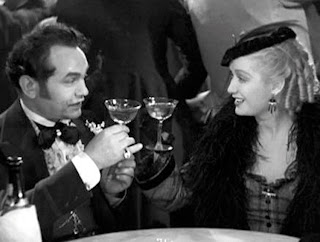 |
| John Beck and Marie-France Pisier |
Although it was not his first published novel, Sydney Sheldon had his first big bestseller with The Other Side of Midnight, a very entertaining "beach" read that was the first to employ his standard formula: Sheldon would take plots from old romantic movies and then add some intrigue and thriller elements to them. Generally it worked, although -- as one critic put it -- no matter how entertaining it was you forgot the book the minute you were finished with it. Oddly, the film version of Midnight was not a success, either financially or critically. Not so odd, maybe.
In 1939 Marseilles Noelle Page (Marie-France Pisier) discovers that her own father has basically sold her to her employer. Disgusted, Noelle sets off to Paris and heartbreak, where she meets a soldier, Larry Douglas (John Beck), who leaves her with child, and promises to return and marry her. Determined to get revenge on the man who never comes back to her, Noelle becomes a wealthy film star. In the meantime Larry meets and marries an American publicist, Catherine (Susan Sarandon of Twilight), even as Noelle moves from lover to lover to become the mistress of the world's wealthiest man, Greek shipping magnate Constantin Demeris (Raf Vallone of Therese Raquin). But she and Larry Douglas are fated to meet again, with dramatic consequences for all the parties already named ...
In the novel Noelle and Larry are described as gorgeous specimens of female and male pulchritude. Pisier is certainly a strikingly attractive woman, but every time you see lantern-jawed Beck making love to her you can't help but see chin-happy Jay Leno. Beck's performance is competent but not so great that you can understand his casting, but then the producers obviously wanted to save money by using relative unknowns. Sarandon and Pisier certainly earn their paychecks with well-crafted performances -- in addition Pisier is forced into bedroom scenes with one [comparatively speaking] ugly old man after another, making the flesh crawl, and even Larry isn't so great! These sex scenes go on for an excruciatingly long time. The producers wanted to provide long glimpses of Pisier's lovely body, obviously, but forgot that we had to look at her unlovely bed mates as well!
If you approach the film without ever having read the book, you may find it reasonably entertaining if quite long. [In fact, it takes longer to watch the movie, which is nearly three hours long, than it does to read the book!] The trouble is that Jarrott directs with absolutely no panache, stripping the film of most of its suspense. Though the movie has pretty settings and attractive scenic design, the cinematography is flat and uninspired -- it all looks like a matter-of-fact hastily done TV movie. Jarrott had more success with Mary, Queen of Scots; with Midnight he seems utterly bored with the material.
Despite the film's length, some of the novel's most interesting sequences have been left out. Midnight may not have been a literary masterpiece, but a better film could have been made of it with a little more care and inspiration.
Verdict: Even Sheldon deserves better. **1/2.
























